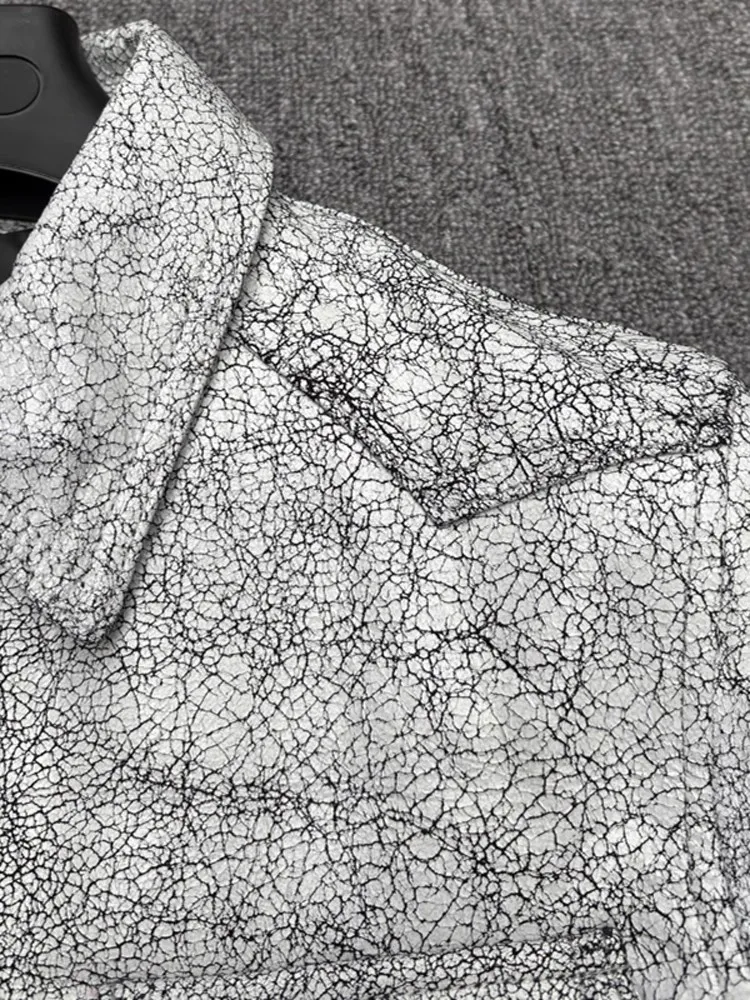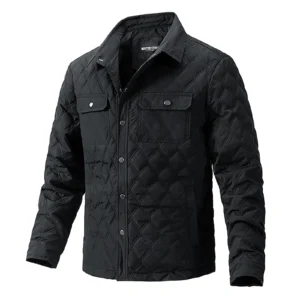Introduction to Leather Coat Care
A quality leather coat represents more than just an article of clothing—it’s an investment in style and durability. With proper care, these timeless pieces can last decades, becoming more characterized and distinguished with age. However, using the wrong cleaning products can dramatically shorten their lifespan, causing irreversible damage to the material.
Proper leather coat maintenance is essential for several reasons:
- Regular cleaning extends your coat’s life by up to 3-5 times compared to neglected garments
- Appropriate care preserves the natural oils in leather that keep it supple and resistant to cracking
- The right cleaning regimen enhances rather than diminishes leather’s unique patina and character
- Quality care protects what is often a significant financial investment
Many leather coat owners learn this lesson the hard way when household cleaners leave permanent stains or harsh chemicals strip away protective finishes. The key to avoiding these scenarios lies in understanding that not all leather cleaners are created equal—different formulations serve different purposes and leather types.
Throughout this guide, we’ll explore the various types of leather cleaners available, how to match them to specific leather types, and proper application methods to keep your coat looking its best for years to come. Establishing the right leather coat care maintenance routine is the first step toward preserving your investment.
Understanding Leather Types and Their Cleaning Requirements
Before selecting a leather cleaner, it’s crucial to identify what type of leather your coat is made from, as each variety has unique properties and cleaning needs.
Common Leather Types in Coats
Full-Grain Leather
– The highest quality and most durable leather available
– Shows natural markings, pores, and character
– Develops a rich patina over time
– Requires gentle cleaning to preserve natural surface qualities
Top-Grain Leather
– Sanded to remove imperfections, creating a more uniform appearance
– Thinner and more pliable than full-grain
– Often treated with protective finishes
– Accepts a wider range of cleaners due to protective coating
Genuine Leather
– Made from lower layers of the hide
– More processed and less durable
– Often painted or embossed to improve appearance
– Can withstand stronger cleaners but requires regular conditioning
Suede
– Made from the inner split of the hide with a napped, fuzzy surface
– Highly susceptible to water damage and staining
– Requires specialized cleaning products and techniques
– Cannot be treated with liquid cleaners without risking damage
Nubuck
– Created by sanding the outer grain to create a velvet-like finish
– More durable than suede but still delicate
– Water-resistant but easily stained
– Needs specific cleaners formulated for napped finishes
Aniline Leather
– Dyed with soluble dyes without surface coating
– Shows all natural markings
– Highly absorbent and susceptible to staining
– Requires very gentle, specialized cleaning products
Semi-Aniline
– Light protective coating over dyed leather
– Balance of natural appearance and increased protection
– Moderately resistant to staining
– Accepts mild cleaners with less risk of damage
The porosity, finish type, and treatment of your leather coat significantly impact cleaner selection. More porous leathers like suede and aniline readily absorb liquids—including cleaners—making them vulnerable to water spots and oversaturation. Coated leathers can handle a wider variety of products but may be damaged by solvents that break down their protective finish.
Most quality leather coats include a care tag indicating the specific leather type, which should be your first reference point. Visual identification is also possible: full-grain leather shows natural pores and markings; top-grain has a more uniform appearance; suede and nubuck have a soft, napped surface; while finished leathers have a smooth, sometimes slightly glossy surface.
Understanding these distinctions is essential when browsing mens leather shearling coats or any leather garment, as the appropriate cleaner will preserve rather than damage your coat’s unique characteristics.
Categorizing Leather Cleaners: Forms and Applications
Leather cleaners come in various forms, each designed for specific applications and leather types. Understanding these differences helps ensure effective cleaning without damaging your coat.
Major Leather Cleaner Categories
| Cleaner Type | Best For Leather Types | Advantages | Disadvantages | Ideal Use Case |
|---|---|---|---|---|
| Spray | Most finished leathers | Even application, quick drying | Potential overspray | Regular maintenance |
| Cream | Full/top-grain, genuine | Deep conditioning, effective on grime | Requires more buffing | Moderate cleaning needs |
| Liquid | Most leather types | Versatile, adjustable strength | Risk of oversaturation | General cleaning |
| Wipes | Finished leathers | Convenience, portability | Limited cleaning power | On-the-go touch-ups |
| Foam | Delicate leathers | Gentle, controlled application | May not tackle tough stains | Light cleaning of delicate pieces |
Spray Cleaners
Spray cleaners offer convenient, even application across large surfaces of leather coats. They typically provide a fine mist that prevents oversaturation—a common cause of water damage in leather. These cleaners work well for regular maintenance and removing light dust and surface dirt. They’re particularly effective on finished leathers that have some degree of water resistance.
Cream Cleaners
Cream-based formulations excel at providing deep cleaning while simultaneously conditioning the leather. Their thicker consistency allows for controlled application and is ideal for addressing moderate dirt buildup. Many cream cleaners contain natural oils that nourish the leather during cleaning. They’re particularly well-suited for full-grain and top-grain leathers that benefit from the additional conditioning properties.
Liquid Cleaners
These versatile cleaners range from mild to intensive formulations. Their liquid consistency makes them adaptable for various cleaning scenarios, from general maintenance to deeper cleaning. The major advantage is control over dilution—you can adjust the strength based on cleaning needs. However, proper technique is essential to avoid oversaturation that could lead to water spots or damage.
Wipe Cleaners
Pre-moistened leather cleaning wipes offer unmatched convenience for quick spot cleaning and on-the-go maintenance. They’re ideal for addressing small spills before they set or for refreshing your leather coat when traveling. While not powerful enough for deep cleaning, they excel at maintenance cleaning and immediate stain response.
Foam Cleaners
Foam formulations provide gentle cleaning action that’s particularly valuable for delicate or unfinished leathers. The foam consistency limits oversaturation risk while still providing effective cleaning. These cleaners are often used on higher-end leather coats where preserving the natural characteristics of the leather is paramount.
The consistency of your chosen cleaner directly impacts its effectiveness on different leather types. Thicker creams work better on more porous leathers by preventing rapid absorption, while sprays and liquids may penetrate more quickly and evenly on finished leathers. When cleaning leather coats at home, matching the right cleaner consistency to your specific leather type ensures optimal results without damage.
Specialized Cleaners for Delicate Leather Types
Suede and nubuck present unique cleaning challenges due to their delicate, napped surface. Using standard leather cleaners on these materials can permanently damage their distinctive texture and appearance.
Special Tools for Suede and Nubuck
Suede Brushes
These specialized tools come in several varieties, each serving a specific purpose:
– Brass bristle brushes: Ideal for raising nap and removing stubborn stains
– Rubber brushes: Perfect for general cleaning and removing dry surface dirt
– Nylon brushes: Gentler option for regular maintenance and dust removal
The proper brushing technique involves working in one direction to maintain an even nap rather than circular motions that can create uneven patterns in the suede.
Suede Erasers
These specialized blocks remove localized stains through gentle abrasion. Similar to a pencil eraser in texture but formulated specifically for suede, they’re effective on:
– Oil spots (after absorbent powder treatment)
– Small scuffs and marks
– Water spots (after complete drying)
To use effectively, gently rub the eraser over the stained area, then brush with a suede brush to restore the nap.
Specialized Spray Cleaners
Suede-specific spray formulations clean without saturating or matting the napped surface. These products typically:
– Contain minimal moisture
– Include gentle solvents that evaporate quickly
– Leave no residue that could flatten the nap
– Often incorporate stain-repellent properties
When using liquid products on napped leathers, extreme caution is necessary. Over-application can permanently mat the nap, creating shiny spots that cannot be restored. Always test in an inconspicuous area first, and use the minimum amount necessary to address the issue.
In emergencies, some household items can substitute for specialized tools:
– Clean pencil erasers can work similarly to suede erasers
– Fresh bread crumbs can absorb oil from fresh stains
– Fine emery boards can gently restore nap in small areas
For owners of mens sheepskin coats, these specialized cleaning techniques are particularly important, as these garments often feature suede or nubuck exteriors that require delicate care to maintain their luxurious appearance and feel.
Stain-Specific Leather Cleaners
Certain stains on leather coats require specialized cleaning solutions designed to target specific molecular structures without damaging the leather itself.
Oil and Grease Removers
- Absorbent powders (cornstarch, talcum powder, baking soda) work by drawing oils out of leather
- Apply generously to fresh stains, leave overnight, then brush away
- For set-in stains, specialized degreasers containing mild solvents break down oils while preserving leather
- Particularly useful for collar areas where hair products and body oils accumulate
Ink and Dye Stain Solutions
- Alcohol-based formulations designed specifically for leather (never use pure rubbing alcohol)
- Professional ink removers containing balanced solvents that target ink without affecting leather dyes
- Apply with cotton swabs for precise control rather than saturating larger areas
- Success rates are higher on finished leathers than on absorbent, unfinished varieties
Water Spot and Salt Stain Removers
- Specialized solutions that balance the pH of water marks
- Often contain mild acids (like diluted vinegar) to neutralize alkaline salt deposits
- Particularly important for winter coat care when exposure to road salt is common
- Must be followed by proper conditioning to restore moisture balance
Mold and Mildew Solutions
- Formulations containing mild fungicides safe for leather use
- Often include isopropyl alcohol in controlled concentrations
- Designed to kill spores without drying out leather
- Critical for coats stored in humid environments or those affected by improper storage
General all-purpose leather cleaners typically lack the specific chemical properties needed to address these particular challenges. Standard cleaners may spread stains (especially ink), fail to break down oils, or prove ineffective against biological contaminants like mold.
The effectiveness of stain-specific cleaners comes from their targeted approach to molecular bonds. For example, ink removers contain solvents that dissolve the specific dyes in ink without affecting the more stable dyes used in leather processing. Similarly, oil removers use surfactants that bond with oil molecules to lift them from leather’s fibers.
For owners of winter coats who frequently encounter salt stains and water spotting, having these specialized cleaners on hand can mean the difference between permanent damage and successful restoration.
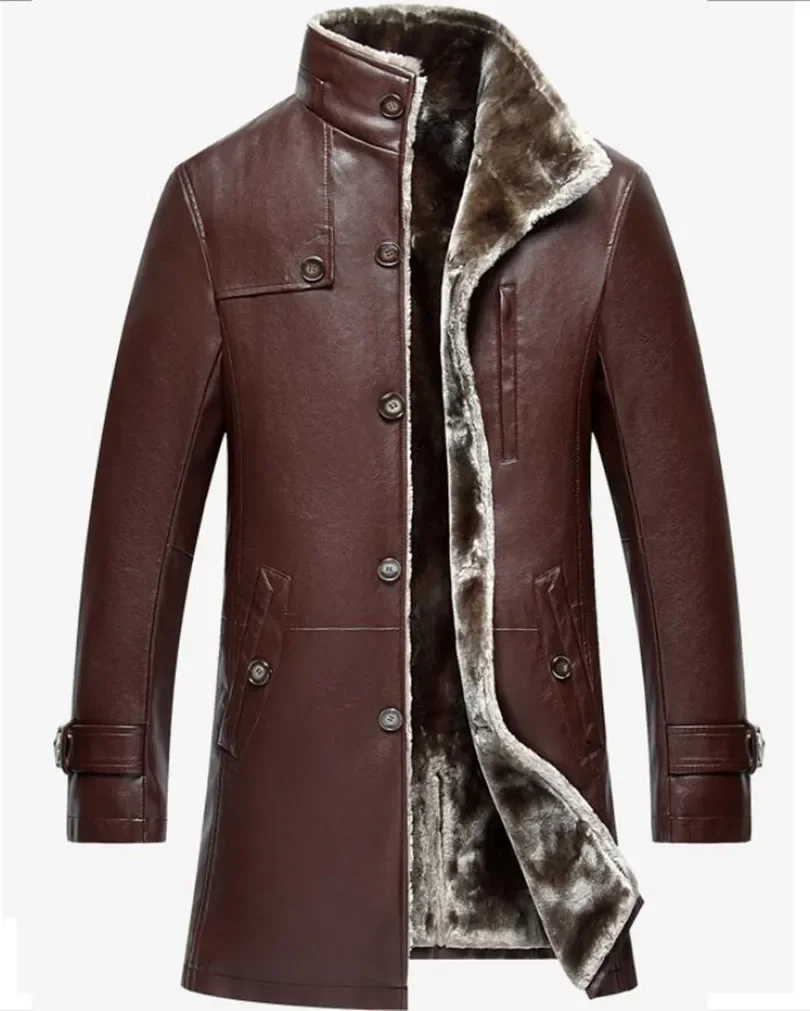
Key Ingredients: What to Look For and Avoid
The effectiveness and safety of leather cleaners depend largely on their ingredients. Understanding what makes a quality formulation can help you select products that clean effectively without causing damage.
Beneficial Ingredients
pH-balanced Formulas (4.5-5.5 range)
– Match leather’s naturally acidic pH
– Prevent alkaline damage that can weaken fiber structure
– Maintain leather’s natural properties during cleaning
Natural Oils
– Jojoba oil: Similar to leather’s natural oils, helps replace what cleaning removes
– Neatsfoot oil: Traditional leather conditioner that penetrates deeply
– Lanolin: Provides water resistance and conditioning during cleaning
Gentle Surfactants
– Coconut-derived cleaners that lift dirt without harsh chemicals
– Vegetable-based soaps specifically formulated for leather
– Balanced cleaners that remove dirt without stripping natural oils
Water-based Solutions
– Appropriate for most finished leathers
– Lower toxicity and environmental impact
– Less likely to cause damage than solvent-heavy formulations
Harmful Ingredients to Avoid
Harsh Solvents
– Acetone: Strips finish and natural oils
– High-concentration alcohol: Dries and cracks leather
– Turpentine: Too aggressive for most leather finishes
Petroleum Distillates
– Create buildup that prevents leather from breathing
– May dissolve adhesives used in coat construction
– Can cause premature aging and cracking
Silicone
– Creates temporary shine but builds up over time
– Prevents leather from absorbing necessary conditioners
– Difficult to remove once applied
Excess Waxes
– Trap moisture inside leather, promoting mildew
– Create sticky surfaces that attract more dirt
– Can cause uneven appearance on leather surface
Animal Products Prone to Decay
– Raw animal fats that become rancid over time
– Unstabilized proteins that can promote bacterial growth
– Untreated animal derivatives that attract pests
Many common household cleaners contain ingredients that devastate leather. For example, ammonia-based glass cleaners may provide immediate shine but cause long-term drying and cracking. Similarly, saddle soaps designed for work boots may be too harsh for fine leather coats.
Research shows pH-balanced cleaners maintain leather strength and flexibility up to three times longer than alkaline cleaners. The natural acidity of leather (around pH 4.5-5.5) means alkaline products (like many household cleaners) break down its structure at a molecular level.
When considering your leather coat conditioning expert tips, remember that the cleaning products you choose directly impact how well conditioning treatments are absorbed and how effectively they protect your garment.
Selecting the Right Leather Cleaner: Decision Criteria
Choosing the appropriate leather cleaner requires a systematic approach based on your specific coat’s characteristics and cleaning needs.
Step 1: Identify Your Leather Type
- Examine the coat’s care label for specific leather type information
- Assess surface appearance: smooth and shiny (finished), textured with visible pores (full-grain), or napped (suede/nubuck)
- Consider the coat’s flexibility and thickness, which indicate processing methods
- When in doubt, assume the more delicate category for safer cleaning
Step 2: Evaluate the Finish
- Protected leather (coated): Has a sealed surface that repels water droplets
- Semi-protected: Water slowly absorbs but doesn’t immediately stain
- Unprotected: Readily absorbs water, showing immediate darkening
- Napped finishes: Never water test; identify by the raised surface texture
Step 3: Categorize the Soil/Stain
- Surface dust and light soil: Requires minimal cleaning power
- Set-in dirt and minor stains: Needs moderate cleaning strength
- Specific stains (oil, ink, water spots): Demands targeted cleaners
- Multiple stain types: May require sequential treatment with different products
Step 4: Consider Coat Value and Age
- Vintage or high-value coats merit more cautious, specialized cleaning
- Newer coats with intact finishes can often handle standard cleaners
- Antique leathers may have different tanning methods requiring special care
- Consider professional cleaning for irreplaceable pieces
Step 5: Assess Environmental Factors
- High humidity environments require cleaners that don’t add excess moisture
- Very dry climates call for cleaning products with added conditioning
- Consideration of storage conditions affects cleaner selection
- Regular exposure to specific contaminants (city pollution, wood smoke) influences choice
Balancing Effectiveness vs. Gentleness
For everyday care of moderately soiled coats, choose the mildest effective cleaner. Escalate to stronger products only when necessary, and always spot test first.
For example:
– A new top-grain leather coat with light surface dust → pH-balanced spray cleaner
– A vintage full-grain leather jacket with oil stains → absorbent powder followed by specialized leather degreaser
– A suede coat with water spots → suede-specific cleaner and brush kit
Professional cleaning becomes the safer option when:
– The coat has significant value (financial or sentimental)
– Stains are extensive or involve unknown substances
– Previous cleaning attempts have been unsuccessful
– The leather has unusual or delicate finishing
Understanding the differences between genuine leather vs faux leather also affects your cleaning approach, as synthetic alternatives often require completely different care methods than authentic leather.
Application Techniques: Step-by-Step Cleaning Guide
Proper application technique is just as important as choosing the right cleaner. Follow these steps for effective leather coat cleaning:
1. Preparation
- Thoroughly dust the coat using a soft cloth or vacuum with brush attachment
- Lay coat on a clean, flat surface or place on a padded hanger
- Test cleaner on an inconspicuous area (inner lining area, inside collar) and wait 24 hours
- Prepare your workspace with good lighting and organize necessary tools
- Remove items from pockets and protect hardware with painter’s tape if using liquid cleaners
2. Cleaner Preparation
- Read manufacturer’s instructions completely before beginning
- Dilute products as directed, never using stronger concentrations
- Prepare appropriate applicators: microfiber cloths, sponges, or soft brushes
- Pour small amounts into a separate container rather than using directly from bottle
- Allow solutions to reach room temperature if stored in cold locations
3. Application Methods
- Work in small sections (approximately 8×8 inches) to ensure thorough cleaning
- Use gentle circular motions for smooth leathers, working from the center outward
- Apply with straight, nap-following strokes for suede and nubuck
- Use minimal product—leather needs less cleaner than you might expect
- Allow recommended dwell time before wiping or rinsing as directed
4. Drying Techniques
- Blot excess moisture with clean, dry microfiber cloths
- Allow to air dry naturally, away from direct heat sources
- Maintain good air circulation around drying garments
- Keep coat on shaped hanger or stuff with acid-free tissue to maintain shape
- Never use hair dryers, heaters, or sunlight to speed drying
5. Post-Cleaning Assessment
- Examine cleaned areas for residue or inconsistent appearance
- Evaluate if additional cleaning is needed for stubborn spots
- Allow coat to dry completely before deciding if further treatment is necessary
- Document successful techniques for future reference
Special Considerations for Coat Features
- Clean around seams with a soft cloth wrapped over your fingertip for precision
- Use cotton swabs for cleaning around buttons, zippers, and decorative hardware
- Avoid saturating areas with multiple layers of leather or near adhesive bonds
- Clean collars and cuffs more frequently as they collect more oils and dirt
- Use extra caution around perforated leather to prevent cleaner from seeping through
For smooth finished leather, apply cleaner using light pressure in a circular motion. For suede and nubuck, use gentle straight strokes in the direction of the nap to avoid creating uneven patches.
Recommended timing between application and removal varies by product type:
– Spray cleaners: Usually wiped immediately before drying
– Cream cleaners: Often allowed to penetrate for 1-2 minutes
– Foam cleaners: Typically left to work for 30 seconds to 1 minute
– Liquid cleaners: Generally wiped away promptly to prevent oversaturation
These techniques apply to various leather garments, from casual jackets to formal long-term leather coat care routines.
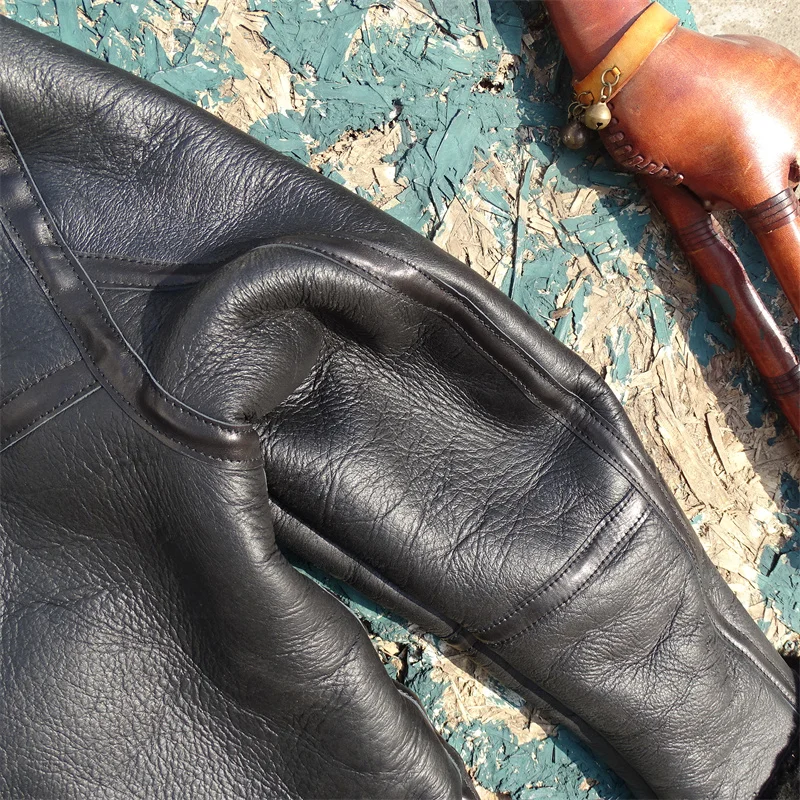
Tackling Common Stains on Leather Coats
Different stains require specific treatment approaches to ensure successful removal without damaging your leather coat.
Oil and Grease Stains
Fresh Stains:
1. Blot (don’t rub) excess oil immediately with a clean, dry cloth
2. Apply absorbent powder (cornstarch, talcum powder, or baking soda) liberally
3. Leave powder on the stain for 4-6 hours or overnight
4. Brush away powder gently and repeat if necessary
5. For remaining residue, use a leather degreaser designed for your leather type
Set-In Stains:
1. Apply leather-specific degreaser using a clean cloth
2. Work in gentle circular motions from outside toward center
3. Allow to work for manufacturer’s recommended time
4. Wipe away with a clean cloth
5. Repeat if necessary, allowing leather to dry between applications
These techniques are particularly effective for collar areas where hair products and natural oils accumulate, and for food spills on front panels of coats.
Ink Marks
- Avoid spreading by using precise application tools like cotton swabs
- Apply specialized leather ink remover sparingly to the affected area
- Dab rather than rub to lift ink into the cloth
- Work from outside edges toward the center
- Allow to dry completely between applications
Success rates are highest on fresh ink stains and finished leathers. For valuable coats with ink damage, professional cleaning is often the safest approach.
Water and Salt Stains
- Mix a solution of equal parts white vinegar and water
- Dampen (don’t soak) a cloth with the solution
- Gently wipe affected areas using minimal moisture
- Follow immediately with a clean, damp cloth to remove residue
- Allow to dry completely, then condition the treated area
This treatment works best on water spots and winter salt stains that leave white residue on dark leather. Proper dilution is critical—too much vinegar can damage leather dyes.
Mold and Mildew
- Move to a well-ventilated area and wear a mask
- Brush away surface mold with a soft brush
- Apply a leather-safe fungicidal cleaner with minimal moisture
- Allow to dry completely in a well-ventilated area
- Apply preventive treatment if recommended by the manufacturer
For all stains, timing is crucial. Fresh stains are almost always easier to remove than set-in ones. When dealing with unknown stains or particularly valuable coats, consulting long-term leather coat care guide resources or professional cleaners is often the wisest approach.
The Essential Role of Conditioning After Cleaning
Cleaning leather removes not just dirt but also the natural oils that keep the material supple and resistant to cracking. This makes conditioning an essential follow-up step to any cleaning process.
Why Conditioning is Critical
When you clean leather, you strip away:
– Natural oils that prevent drying and cracking
– Protective substances that guard against moisture damage
– Lubricants that maintain flexibility between leather fibers
Without replacing these elements through conditioning, cleaned leather can become:
– Stiff and uncomfortable to wear
– Prone to cracking, especially in stress areas like elbows
– More susceptible to future staining as it absorbs liquids more quickly
– Vulnerable to premature aging and deterioration
Relationship Between Cleaners and Conditioning Needs
Different cleaning products create varying conditioning requirements:
– Harsh degreasers and alcohol-based cleaners create the greatest need for conditioning
– pH-balanced, gentle cleaners with added moisturizers require less intensive follow-up
– Cream cleaners with built-in conditioners may need minimal additional treatment
– Water-based cleaners typically require moderate conditioning afterward
Conditioning Frequency Guidelines
General recommendations based on wear and climate:
– After every thorough cleaning session
– Every 3-6 months for regularly worn coats
– More frequently (every 1-3 months) in dry climates or winter conditions
– Less frequently (every 6-12 months) in humid environments
– Immediately if leather feels dry or stiff to the touch
Signs Your Coat Needs Conditioning
- Leather feels dry or rough rather than smooth and supple
- Surface appears dull or shows a whitish cast
- Slight cracking appears, especially in fold areas
- Leather feels stiff or makes creaking sounds when moved
- Water no longer beads on the surface but absorbs quickly
A simple touch test can determine conditioning needs: press your finger gently on the leather and release. If the indent remains visible for more than a few seconds, the leather likely needs conditioning.
For comprehensive protection of leather jackets, conditioning is not optional but essential maintenance that extends your garment’s life and preserves its appearance.
Mens Heavy Winter Coat, Mens Insulated Coat, Mens Parka Coat
Price range: $175.52 through $237.36 Select options This product has multiple variants. The options may be chosen on the product pageMens Big and Tall Winter Coats, Mens Down Coat, Mens Hooded Winter Coat, Mens Puffer Coat
Price range: $126.44 through $217.01 Select options This product has multiple variants. The options may be chosen on the product pageMens Big and Tall Winter Coats, Mens Hooded Winter Coat
Price range: $80.32 through $106.68 Select options This product has multiple variants. The options may be chosen on the product pageMens Cashmere Overcoat, Mens Hooded Winter Coat, Mens Wool Blend Coat
Price range: $128.72 through $139.68 Select options This product has multiple variants. The options may be chosen on the product pageMens Hooded Winter Coat, Mens Insulated Coat, Mens Puffer Coat, Mens Quilted Coat
Price range: $139.88 through $177.72 Select options This product has multiple variants. The options may be chosen on the product pageMens Double Breasted Pea Coat, Mens Hooded Winter Coat, Mens Quilted Coat
Price range: $81.00 through $108.48 Select options This product has multiple variants. The options may be chosen on the product page
Common Leather Cleaning Mistakes to Avoid
Even with the best intentions, certain cleaning practices can damage leather coats. Being aware of these common mistakes can help preserve your garment’s appearance and longevity.
1. Using Household Cleaners Not Formulated for Leather
Everyday cleaning products like dish soap, window cleaners, or all-purpose sprays contain chemicals that strip leather’s natural oils and damage finishes. These products often have high pH levels that break down leather’s structure over time. Instead, invest in cleaners specifically formulated for leather care.
2. Oversaturating Leather With Water or Cleaner
Leather is skin—it can only absorb limited moisture before becoming damaged. Excessive liquid can lead to water stains, warping, and in severe cases, mold growth inside the lining. Apply cleaners sparingly, working with damp rather than wet cloths.
3. Aggressive Scrubbing That Damages Grain Structure
Forceful rubbing, especially with abrasive materials, can wear away the leather’s natural grain or protective finish. This creates thin spots prone to cracking and tearing. Always clean with gentle circular motions using soft cloths.
4. Skipping Spot Testing on Inconspicuous Areas
Every leather coat responds differently to cleaners based on its specific tanning process, dye, and finish. A cleaner that works perfectly on one coat might discolor another. Always test products on hidden areas like inner seams and wait 24 hours to observe results.
5. Rushing the Drying Process With Heat Sources
Direct heat from hair dryers, radiators, or sunlight causes leather to dry too quickly, leading to stiffness, shrinkage, and cracking. Always allow leather to dry naturally at room temperature with good air circulation.
6. Over-Conditioning, Creating Sticky Residue
While conditioning is essential, too much product creates a sticky surface that attracts dirt and can stain clothing. Apply conditioner sparingly and buff thoroughly to remove excess.
7. Using One Cleaner for All Leather Types
A cleaner designed for finished leather can ruin suede, while suede cleaners might be ineffective on protected leather. Match cleaning products specifically to your coat’s leather type and finish.
8. Neglecting Regular Maintenance Cleaning
Waiting until leather is visibly soiled often means stains have set deeply. Regular light cleaning prevents dirt buildup that requires harsher cleaning later. Gentle dusting and occasional light cleaning extend time between deep cleanings.
Correcting Mistakes
If you’ve made one of these errors:
– For oversaturation: Blot excess immediately and allow slow, natural drying
– For household cleaner damage: Neutralize with pH-balanced leather cleaner, then condition thoroughly
– For over-conditioning: Remove excess with leather cleaner designed to cut oil
– For heat damage: Condition thoroughly and repeat regularly to restore flexibility
Metro Cloak understands the importance of proper care for premium outerwear. When selecting from our collection of mens leather coats, remember that proper cleaning techniques preserve your investment for years to come.
Seasonal Storage and Maintenance Tips
Proper leather coat care varies throughout the year. Following a seasonal maintenance schedule ensures your garment remains in excellent condition regardless of whether it’s in active use or storage.
Pre-Storage Cleaning and Conditioning
Before storing your leather coat for the off-season:
– Clean thoroughly to remove all dirt and oils that could set during storage
– Address any stains, as they become more difficult to remove over time
– Apply a light conditioning treatment to prevent drying during storage
– Allow 24-48 hours for products to fully absorb before packing away
Summer Storage Methods
Proper summer storage protects your coat from heat, humidity, and pests:
– Use breathable cotton garment bags rather than plastic, which traps moisture
– Place cedar blocks or lavender sachets nearby to repel moths (avoid direct contact)
– Store on broad, padded hangers that maintain shoulder shape
– Keep away from direct sunlight, which fades and dries leather
– Maintain stable, moderate temperature and humidity (ideally 60-80°F with 40-50% humidity)
Fall Preparation
As cooler weather approaches:
– Remove from storage and inspect thoroughly for any issues
– Air out the coat in a well-ventilated area away from sunlight
– Apply a light conditioning treatment if leather feels dry
– Test all hardware (zippers, buttons) and address any functional issues
– Consider applying a leather protector for water and stain resistance
Winter Cleaning Frequency
During heavy use seasons:
– Wipe down with a dry cloth after each wearing to remove surface dirt
– Clean salt stains immediately as they can permanently damage leather
– Apply leather protector more frequently if exposed to snow and rain
– Pay special attention to collar, cuffs, and pocket areas that contact skin oils
– Schedule deeper cleaning monthly if worn regularly in harsh conditions
Quick-Response Protocols
For unexpected spills or exposure:
– Blot (don’t rub) liquid spills immediately
– Address salt exposure by wiping with a damp cloth, then drying
– Keep leather wipes in your car or bag for immediate spot treatment
– Remove the coat from wet conditions as soon as possible and allow to dry naturally
– Apply conditioner to areas that were wet after they’ve completely dried
Proper storage includes maintaining the coat’s shape with padded hangers—wire hangers create pressure points that can permanently distort shoulders. For long-term storage, consider the detailed approaches outlined in our expert guide for long-term leather coat storage.
Professional Cleaning: When to Seek Expert Help
While many leather cleaning tasks can be handled at home, certain situations warrant professional expertise to avoid costly mistakes.
When to Consider Professional Services
Valuable or Vintage Coats
– Irreplaceable heirloom pieces
– High-end designer garments
– Antique leather with historical value
– Coats with significant monetary worth
Extensive or Challenging Stains
– Large, set-in stains covering substantial areas
– Unknown substances that resist identification
– Dark stains on light-colored leather
– Multiple stain types overlapping each other
Special Finishes or Exotic Leathers
– Hand-finished or hand-antiqued leathers
– Exotic skins (alligator, ostrich, etc.)
– Metallic or iridescent finishes
– Specially dyed or painted leather surfaces
Structural Issues Combined with Cleaning Needs
– Lining separation needing repair while cleaning
– Hardware issues requiring professional attention
– Torn seams or damaged areas near stains
– Color restoration combined with cleaning
Selecting a Qualified Leather Cleaning Professional
Look for these qualifications when choosing a service provider:
– Specialization in leather cleaning (not just general dry cleaning)
– Membership in professional organizations like the Leather Conservation Centre
– Before and after photos of similar projects
– Specific experience with leather outerwear (not just furniture)
– Clear explanation of processes they’ll use on your specific coat
Questions to Ask Before Entrusting Your Coat
- What specific cleaning process will be used for my coat’s leather type?
- What solutions and products do you use, and are they pH-balanced?
- Do you test in inconspicuous areas before proceeding?
- What is your approach to conditioning after cleaning?
- Do you offer any guarantee or warranty on your work?
- How long have you been cleaning leather garments specifically?
Professional Cleaning Processes
Professional leather cleaners typically have access to:
– Specialized testing equipment to identify leather types and finishes
– Commercial-grade cleaning solutions not available to consumers
– Controlled drying environments with proper temperature and humidity
– Color matching and restoration capabilities for damaged areas
– Advanced stain extraction methods that minimize leather exposure to moisture
Professional services typically range from $50-$200 depending on the coat’s condition, size, and leather type. While this represents a significant investment, it’s often worthwhile for valuable pieces or challenging cleaning situations.
For owners of premium garments like mens black leather coats, professional cleaning every few years can complement regular home maintenance to ensure maximum longevity.
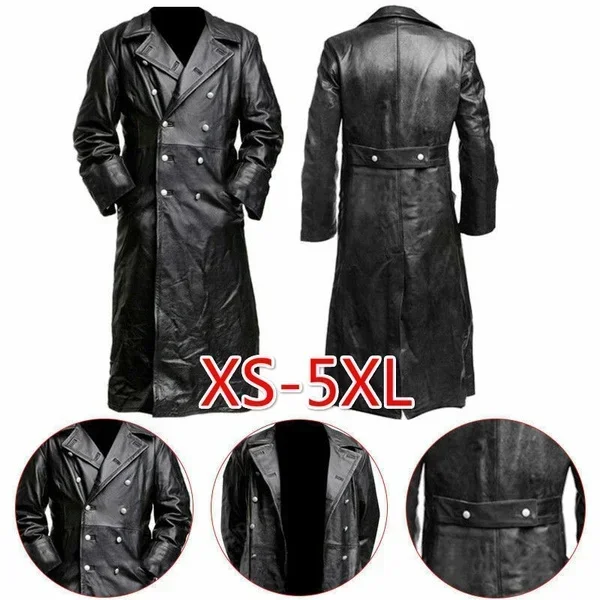
Recommended Leather Cleaning Products for Different Coat Types
While specific brand recommendations can change over time, understanding the qualities that make excellent leather cleaning products will help you make informed choices regardless of what’s currently on the market.
All-Purpose Leather Cleaners for Everyday Care
Look for these qualities in general maintenance cleaners:
– pH-balanced formulation (4.5-5.5 range)
– Non-detergent based surfactants
– Low water content to minimize moisture exposure
– Free from silicone, waxes, and petroleum distillates
– Mild, natural ingredients like coconut-derived cleaners
These versatile cleaners work well for regular dusting and light cleaning of finished leather coats, removing surface dirt before it becomes embedded.
Specialized Cleaners for Suede and Nubuck
Quality suede care products typically offer:
– Dry or nearly-dry cleaning approach
– Specialized applicator brushes with proper bristle stiffness
– Rubber-based cleaning compounds that lift dirt without moisture
– Quick-drying formulations when liquid is necessary
– Nap restoration capabilities
Complete suede care kits often include multiple tools (brush, eraser, cleaner) for comprehensive care of these delicate materials.
Effective Stain Removers for Specific Problems
When selecting targeted stain solutions, prioritize:
– Specific formulation for the stain type (oil, ink, water)
– Gentle solvents that won’t damage leather dyes
– Precise application methods (dabbers, small brushes)
– Clear instructions for working time and removal
– Neutral pH to avoid damaging leather structure
The most effective specialized cleaners focus on specific problems rather than claiming to handle everything.
Complementary Conditioners
After cleaning, quality conditioners should provide:
– Natural oils that mimic leather’s own properties
– Absence of petroleum products or mineral oils
– Non-greasy finish that doesn’t attract dirt
– UV protection when possible
– Appropriate viscosity for your leather type
Look for conditioners specifically matched to your cleaner, as many manufacturers design complementary products that work together effectively.
For comprehensive care of premium leather garments from Metro Cloak, consider creating a complete care kit with appropriate cleaners, conditioners, and specialized tools matched to your specific coat type. This systematic approach ensures you’re prepared to address both routine maintenance and unexpected cleaning challenges.

